Suchergebnisse
Urbaner Kältebedarf in Österreich 2030/2050 (UKÖ 2030/2050)
Systematische Aufarbeitung des steigenden Kühlbedarfs und Darstellung der geographischen Verortung des Kältebedarfs in Österreich. Das Ergebnis dient als Entscheidungshilfe bei der Entwicklung von Klimaschutzmaßnahmen und Klimawandelanpassungsstrategien sowie eine Abschätzung zum Kältebedarf der Zukunft.
IEA Experts Group "R&D Priority Setting and Evaluation" (EGRD) - Working period 2017 - 2019
The IEA Experts Group (EGRD) was established by the Committee on Energy Research and Technology (CERT). It examines analytical approaches to energy technologies, policies, and research and development and evaluates the benefits of RTI policies. Its results and recommendations feed into IEA analysis, and enable a broad perspective of energy technology issues.
Ausschreibung: 100% Erneuerbare-Energien-Reallabore
Mit der Ausschreibung sollen Initialprojekte zum Aufbau von fünf Reallaboren in Österreich gefördert werden, die ein möglichst diversifiziertes Spektrum an unterschiedlichen Regionen und dafür erforderlichen Lösungselementen abdecken. Diese Initialprojekte sollen die Basis für die Reallabore schaffen. Einreichfrist: 19. April 2023
50 grüne Häuser - Entwicklung und Demonstration eines Low-Tech-Grünfassadensystems
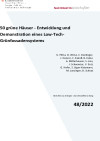
Entwicklung einer kostengünstigen gewerke- und prozessübergreifenden All-In Gebäudebegrünung inkl. Wartungskonzept ("Greening-Toolkit") zur breiten (vor allem straßenseitigen) Implementierung auf Fassaden im städtischen Bestand, kombiniert mit einer Prozessinnovation zur Vereinfachung aller notwendigen Abstimmungsprozesse.
Schriftenreihe
48/2022
U. Pitha, O. Weiss, C. Dantinger, J. Dunzer, C. Kaindl, B. Kainz, A. Mitterhauser, S. Lins, J. Schwanzer, V. Enzi, G. Hofer, S. Jäger-Katzmann, M. Lanzinger, B. Schoas
Herausgeber: BMK
Deutsch, 100 Seiten
Downloads zur Publikation
IEA Industrielle Energietechnologien und Systeme (IETS) Annex 17: Membranfiltration zur energieeffizienten Trennung lignocellulosehaltiger Biomassebestandteile (Arbeitsperiode 2017 - 2021)
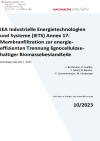
Mit dem IEA IETS TCP Annex 17 wurde das übergeordnete Ziel verfolgt, die Vernetzung der österreichischen Membran- und Bioraffinerie-Forschungslandschaft zu stärken. Angestrebt wurde die optimierte Nutzung von lignozellulosehaltigem Material in Bioraffinerien durch den Einsatz effizienter, nachhaltiger Membranverfahren. Dazu wurden emergierende Membranverfahren auf ihren Einsatz zur Biomassebestandteilsverwertung evaluiert und eine Entscheidungshilfe für deren Anwendung erarbeitet.
Schriftenreihe
10/2023
J. Buchmaier, E. Guillen, S. Meitz, B. Muster, P. Demmelmayer, M. Kienberger
Herausgeber: BMK
Deutsch, 71 Seiten
Downloads zur Publikation
IEA Industrielle Energietechnologien und Systeme (IETS) Annex 15: Industrielle Abwärmenutzung
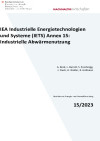
Im Rahmen des IEA IETS Annex 15 (Phase 3) wurden Potentiale für die Nutzung von Abwärme sowie Technologien zu deren Integration durch Beiträge aus nationalen Forschungstätigkeiten gesammelt, gebündelt und aufgearbeitet. Die Beiträge des österreichischen Konsortiums umfassten Technologieentwicklung und Integrationskonzepte von Wärmepumpen- und Energiespeichern, Risikoanalysen bei der Umsetzung von Abwärmeprojekten und Arbeiten zur Betriebsoptimierung und Auslegung von hybriden Energiesystemen.
Schriftenreihe
15/2023
A. Beck, L. Burrell, S. Puschnigg, J. Fluch, H. Walter, R. Hofmann
Herausgeber: BMK
Deutsch, 54 Seiten
Downloads zur Publikation
Weltraumdaten für die nachhaltige Bau- & Immobilienwirtschaft
6. September 2023, 14:00 - 17:30 Uhr
Digital Building Demonstration Lab, Wangari-Maathai-Platz 3 / Ebene 4, 1220 Wien
Think big! Was sind Weltraumdaten und -services? Wie können diese für die Bau- und Immobilienwirtschaft einen Mehrwert generieren? Und wie können auch Sie diese Daten in Zukunft profitabel nutzen?
IEA ISGAN Annex 6: Elektrizitäts-Transport und Verteilsysteme (Arbeitsperiode 2021-2022)
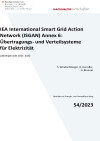
ISGAN Annex 6 befasst sich mit den möglichen systembezogenen Herausforderungen bei der Entwicklung zukünftiger intelligenter Stromnetze. Österreich leitet den Task 4 Interaktion von Übertragungs- und Verteilnetzen. Der Fokus dieses Tasks in diesem Arbeitsprogramm lag auf Flexibilitäts-Topologien innerhalb der Übertragungs- und Verteilungsnetze. Die Ergebnisse und Analysen wurden einerseits im Rahmen eines Diskussionspapiers und in kondensierter Form in einem Video veröffentlicht.
Schriftenreihe
54/2023
S.Windischberger, B. Herndler,H.Brunner
Herausgeber: BMK
Deutsch, 36 Seiten
Downloads zur Publikation
IEA International Smart Grid Action Network (ISGAN) Annex 2: Fallstudien intelligenter Netze (Arbeitsperiode 2019 - 2023)
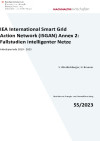
Das Hauptziel dieser Arbeitsgruppe des International Smart Grid Action Netzwerks (ISGAN) ist es, allen relevanten Stakeholdern Zugang zu detaillierten Informationen über den aktuellen Status von Pilot- und Demonstrationsprojekten für intelligente Stromnetze zur Verfügung zu stellen.
Schriftenreihe
55/2023
S. Windischberger, H. Brunner
Herausgeber: BMK
Deutsch, 31 Seiten
Downloads zur Publikation
Blickpunkt Forschung 2023
04. Oktober 2023, 13:00 - 18:00 Uhr
TUthSky, Getreidemarkt 9, 1060 Wien
Zum nunmehr 9.Mal präsentieren Forschende der TU Wien anwendungsnahe Forschungsergebnisse aktueller Forschung. Dieses Jahr wird der Fokus auf Ansätze der Klimaresilienz gelegt.
Sondierung eines Villacher Innovationslabors zur kooperativen Entwicklung von nachhaltigen Quartieren (Villab-Sondierung)
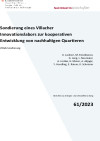
Das Projekt „Villab - Sondierung“ dient der Überprüfung der Machbarkeit eines urbanen Innovationslabors zur Beschleunigung der Transformation Villacher Quartiere in Richtung Klimaneutralität. Die positive Machbarkeit vorausgesetzt, werden die Kooperationen mit relevanten Stakeholdern vertieft und ein Businessplan für ein künftiges Innovationslabor erstellt.
Schriftenreihe
61/2023
U. Lackner, M. Panebianco, G. Lang, L. Neumaier, A. Jordan, H. Moser, A. Alijagic, Y. Hendling, E. Rainer, K. Schreiner
Herausgeber: BMK
Deutsch, 78 Seiten
Downloads zur Publikation
Breakthrough Agenda Report 2023

Der Breakthrough Agenda Report 2023 zeigt, dass die derzeitigen Bemühungen um saubere Energie und nachhaltige Lösungen zwar besser werden, aber noch nicht das Investitions- und Einsatzniveau erreichen, das zur Erreichung der internationalen Klimaziele erforderlich ist. Als Reaktion darauf fordert der Bericht die Regierungen auf, die Zusammenarbeit in Schlüsselbereichen - wie Normen und Regulierung, finanzielle und technische Unterstützung und Marktschaffung - zu verstärken, um den Übergang zu beschleunigen.
Herausgeber: IEA
Englisch, 179 Seiten
Informationsveranstaltung zu aktuellen Energiewende-Ausschreibungen
4. Dezember 2023, 13:00 - 15:00 Uhr
Online
Die FFG stellt zwei vom BMK und vom Klima- und Energiefonds finanzierte Förderinitiativen vor, durch die Projekte, die einen Beitrag zur Erreichung der Klimaneutralitätsziele leisten, unterstützt werden sollen: „100%-Erneuerbare-Energie-Reallbore“ und „Energieforschung“.
IEA DHC Annex TS3: Hybride Energie-Netze, Fernwärme- und -kältenetze im Kontext eines integrierten Energiesystems

Hybride Energienetze, also die Integration von Strom-, Wärme- und Gasnetzen können zur Optimierung des Energiesystems entscheidend beitragen. Der IEA DHC Annex TS3 analysiert Potentiale und Herausforderungen hybrider Energienetze aus Sicht des Fernwärme/Kälte-Systems. Dieses inkludiert die Analyse von Technologien und Synergien, die Bewertung von Tools und Methoden, die Analyse von Fallbeispielen sowie die Entwicklung geeigneter Geschäftsmodelle und Rahmenbedingungen.
Schriftenreihe
72/2023
R.-R. Schmidt, M. Fallahnejad, J. Kelz, L. Kranzl, K. Maggauer, N. Marx, C. Monsberger, D. Muschick, E. Widl
Herausgeber: BMK
Deutsch, 54 Seiten
Downloads zur Publikation
ZERIA 3 (Zero Emissions Research in Application)
Erarbeitung von Methoden zur Umsetzung eines abfall- und emissionsfreien Produzierens. Die Ergebnisse zeigen, dass die Zero Emissions-Option eine reale ist und in vielen Fällen wirtschaftlich erreicht werden kann.
Integral Resource Optimisation Network - Concept
Eine integrale Automatisierungsinfrastruktur zur effizienteren Nutzung der Ressource "elektrische Energie". Konzept für neue, innovative Dienstleistungen basierend auf dem Einsatz der jüngsten Entwicklungen der modernen Informations- und Kommunikationstechnologien.
Mehrgeschossiger Passivwohnbau Utendorfgasse
Anwendung von Passivhaustechnologien im sozialen Wohnbau
Innovationen des S-Houses
19. Oct 2004
Böheimkirchen Zentrum für Angepasse Technologie, Obere Hauptstrasse 383071 Böheimkirchen, AT
Bei einer Baustellenbesichtigung werden die innovativen Komponenten (Strohballen, KLH, Dach etc.) gezeigt. Da diese Elemente, wenn die Bauarbeiten abgeschlossen sind, nicht mehr sichtbar sein werden.
Umwelttechnik-Tagung 2015
2. Oktober - 5. November 2015
Schloss Puchberg, Puchberg 14600 Wels, AT
Ist die Geschichte der Zukunft schon geschrieben? Die Umwelttechnik-Tagung 2015 beschäftigt sich heuer mit den Themenfeldern IT in der Umwelttechnik, Die Zukunft der Arbeit (mit Zukunftsforscher Erik Händeler), Finanzieren neu denken.
2. Bauforum Nachhaltigkeit
24. Nov 2006
Technologiepark, Europastr. 8
9524 Villach, AT
Wissenstransfer von Haus der Zukunft Projekten in das Netzwerk "PartnerInnenpool Nachhaltiges Bauen Kärnten; nabaupool Kärnten" und an interessierte Akteure.
